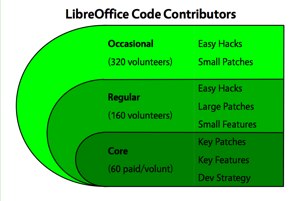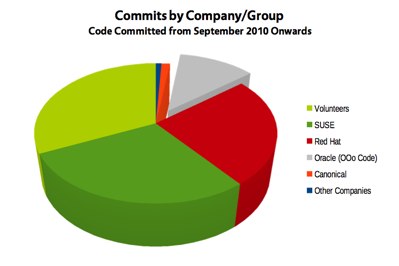There are countless excellent open source software packages available today for virtually every taste and purpose, but it would be difficult to find a better exemplar of open source success than LibreOffice.
Having been born as a fork of OpenOffice.org back in 2010 following widespread community concern over Oracle’s inherited stewardship of that popular package, LibreOffice has gone on to essentially replace its OpenOffice parent as the leading free and open Microsoft Office alternative.
 OpenOffice still exists, to be sure, but it’s LibreOffice that’s now included with most Linux distributions, and it’s LibreOffice that’s being developed most actively.
OpenOffice still exists, to be sure, but it’s LibreOffice that’s now included with most Linux distributions, and it’s LibreOffice that’s being developed most actively.
In many ways, LibreOffice epitomizes the power of open source software.
‘What Many Thought Was Impossible’
The Document Foundation just recently celebrated LibreOffice’s second anniversary, noting that “in just 24 months, we have achieved what many people thought was impossible when the project was launched,” in the words of Thorsten Behrens, SUSE developer and deputy chairman of the Document Foundation Board.
“In just two years we managed to become the third largest free software project focused on the development of a desktop application, with 325 active committers over the last 12 months,” Behrens added, citing Ohloh.net.
In light of this significant milestone, Linux.com spoke recently with Italo Vignoli, director at the Document Foundation, about how far LibreOffice has come as well as what’s still on the way.
The Focus So Far
 “Given the fast time-based release schedule, we seldom have major features, but we frequently have minor improvements, which over time make a major feature,” Vignoli told Linux.com. “In addition, we have focused on several ‘behind the curtains’ features focused on improving the overall quality of the office suite, thanks to a battery of automatic tests which allow us to identify problems before they hit the product.”
“Given the fast time-based release schedule, we seldom have major features, but we frequently have minor improvements, which over time make a major feature,” Vignoli told Linux.com. “In addition, we have focused on several ‘behind the curtains’ features focused on improving the overall quality of the office suite, thanks to a battery of automatic tests which allow us to identify problems before they hit the product.”
LibreOffice development thus far has targeted three main areas, he added:
1. Interoperability
Included in this category are “improvement of OOXML import and export filters in several areas, improvements in VBA macro and form handling, new (Visio, CorelDraw, Publisher) filters or improved (RTF) import filters, and Alfresco and SharePoint integration,” Vignoli explained.
2. Incremental UI Improvements
Some of the notable updates in this area have been user-interface tweaks designed to make the package more attractive and efficient, new templates for the Impress presentation module, and the development of a touch interface for mobile devices, he noted.
3. Performance and Memory
Numerous optimizations in this area “will eventually make the suite leaner and faster,” Vignoli said.
Release pages for LibreOffice 3.3, 3.4, 3.5 and 3.6 offer more specifics about what has already been added to the productivity suite.
 Included among the more notable “behind the curtains” features so far, meanwhile, are a global code cleanup, the translation of German comments into English — aiming to make it easier for hackers from all over to work on the code — and a substantial increase in the number of bug fixes.
Included among the more notable “behind the curtains” features so far, meanwhile, are a global code cleanup, the translation of German comments into English — aiming to make it easier for hackers from all over to work on the code — and a substantial increase in the number of bug fixes.
Coming Soon: Android and Cloud
And what do LibreOffice users have to look forward to?
Some of the highlights of what’s on the way in LibreOffice 3.7 can already be found in the software’s release notes, but the feature list is not yet frozen, so “this is still wildly incomplete,” Vignoli noted.
Nevertheless, “I personally think that the most interesting new developments will be the cloud version and the Android version, which are already in the works,” he said. “We have demonstrated working prototypes of both.”
‘An Incredibly Efficient Machine’
It’s important to keep in mind that free software projects — in which most developers and contributors are volunteers — tend to lack the specific feature roadmap that a proprietary project might have, “as it is impossible to commit on development schedules when you are working during your personal time,” Vignoli pointed out.
At the same time, however, “the fact that we have been keeping up with our time-based release schedule during the last two years shows that our large developer base — over 540 people at the end of September 2012 — is an incredibly efficient self-governing machine,” he added.
Finally, there’s no denying that positive feedback can help: “All this would be useless if users were not to show their ‘silent’ approval by switching to LibreOffice,” Vignoli concluded, “like the City of Munich and the French government.”


